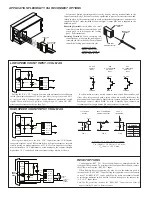
Selection of desired operating modes is easily done by moving terminal leads in the
Input Connector Body. The Connector body is polarized to prevent incorrect insertion, and
locked in place by the connector latch to avoid accidental disengagement. Connectors are
supplied with the 3 leads installed as shown at right. A spare blue lead is supplied in the
hardware pack.
Removing Terminal:
Insert blade of a small
screwdriver into slot of connector body, and
gently push in to disengage the locking
pawl. Pull terminal out.
Inserting Terminal
: When inserting into
connector body, make sure the locking pawl
is toward the slot in the body. Push terminal
in until the locking pawl snaps into slot.
CONNECTOR BODY
MOLEX P/N 2201-2051
CONNECTOR TERMINAL
MOLEX P/N 08-50-0114
APPLICATION FLEXIBILITY VIA RECONNECT OPTIONS
Pulling the “L.S. CNT.” Input to Common with a mechanical or solid-state
switch increments the counter. The low pass filter
(1 meg resistor and 0.015
pf cap)
used with a Schmidt trigger circuit debounces mechanical switch
signals. The switch load is 14 µA
(max. voltage drop 0.5 V)
when ON. OFF-
state leakage current must be less than 2 µA.
Reed switches, mercury wetted contacts, snap action limit switches, and
silver alloy relay contacts with wiping action are usually satisfactory for
generating count input signals. Motor starter contacts, tungsten contacts, and
brush-type contacts should
NOT
be used. Normally open contacts are
recommended for longer battery life and greater noise immunity.
H.S. CNT
.
L.S. CNT
.
REM. RS
T.
RS
T. EN
.
COMM.
CONNECTOR
BODY
22GA STANDARD
WIRE 10" LONG
WHT
YEL
BLK
LOW SPEED COUNT INPUT, 30 Hz MAX.
+3V
MICRO
CHIP
COMM.
0.015pf
1M
300K
BATT.
3.6V
H.S. CNT.
BLK
C
L.S. CNT.
REM. RST.
RST. EN.
COMM.
WHT
Moving the white wire to the “H.S. CNT.” Input allows the CUB Counter
to operate at speeds up to 5 KHz when driven by bi-polar outputs or external
circuits having an output impedance of 3.3 K
Ω
or less. Input drive voltage
must be limited to 3.0 V maximum to avoid damage to the counter. Outputs
higher than 3.0 V can be used with an external voltage divider, as shown.
INPUT PULSE EXCURSION LIMITS
V
in
(High) = +2.0 V min.; +3.6 V max.
V
il
(Low) = +0.5 V max.
+3V
CHIP
COMM.
0.015pf
6.2K
1.3M
BATT.
3.6V
C
MICRO
REM. RST.
RST. EN.
COMM.
BLK
H.S. CNT.
L.S. CNT.
WHT
RESET OPTIONS
Connecting the “RST. EN.”
(Reset Enable)
Input to Common activates the
front panel Reset button. To deactivate the front panel Reset button, remove
the yellow wire from the “RST. EN.” Input.
When Remote Reset is required, the blue wire in the hardware pack is
inserted in the “REM. RST.” Input. Pulling this input low causes the counter
to reset. The “REM. RST.” can be pulled low by either a mechanical switch
or solid-state transistor switch. Switch load and leakage are the same as for
“L.S. CNT.” Input above.
Note: The RC protection circuit on the “REM. RST.” Input causes a delay of
approximately 15 msec in Reset response.
+3V
MICRO
CHIP
COMM.
0.01µf
1M
220K
BATT.
3.6V
H.S. CNT.
BLK
C
L.S. CNT.
REM. RST.
RST. EN.
COMM.
YEL
FRONT
PANEL
RESET
BLUE
REMOTE
RESET
TO COUNT
SIGNAL
COMMON
CONNECTOR
BODY
LOCK PAWL
ENGAGES IN SLOT
CONNECTOR
TERMINAL
HIGH SPEED COUNT INPUT, 5 KHz MAX.
L.S. CNT.
COMMON
L.S. CNT.
COMMON
L.S. CNT.
COMMON
SWITCH
CONTACT
INPUT
NPN
O.C. TRANSISTOR
OR (N) FET
INPUT
PNP
O.C. TRANSISTOR
OR (P) FET
INPUT
3.6 V
MAX.
R
L
SEE
TEXT
H.S. CNT
COM
+5 VDC
COM
3.3 K
H.S. CNT R
+V
COM
H.S. CNT
3.3 K
R
+V
FIG 1
FIG 2
FIG 3
TTL OR CMOS
OUTPUT
PNP O.C. TRANSISTOR
OR BI-POLAR OUTPUT
NPN O.C.
TRANSISTOR
R VALUES
+V
R
+5 V 2.2 K
+12 V 10 K
+18 V 16 K
+24 V 24 K




















